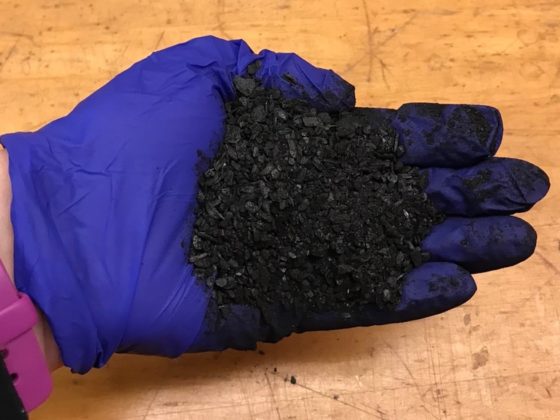In November, the Global Water Initiative held its second Graduate Water Colloquium, bringing together some 40 graduate students and faculty who study water-related questions at UVA. Graduate students from systems engineering, environmental engineering, environmental science, and architecture presented their work. The effort was led by Professors Teresa Culver and Maria Rossetti. The selection committee chose Charles Burgis and Faria Tuz Zahura, both graduate students in engineering, as joint winners of the GWI Prize. Burgis discussed “Tracking Denitrification in Green Stormwater Infrastructure with Nitrate Stable Isotopes,” and Zahura presented “Assessing a Machine Learning Surrogate for a Detailed Physics-Based Model Used to Predict Urban Coastal Street Flooding.” In two Q&As we present their work.
Where does nitrogen in stormwater come from, and why do you want to remove it?
Sudden discharges of stormwater from paved surfaces results in flooding, erosion, sewer overflows, and pollution into our water resources. Nitrogen is one of those pollutants, and stormwater transports it through watersheds from landscape sources such as fertilizers, manure, and wastewater, as well as from atmospheric sources such as lightning and industrial and fossil-fuel combustion emissions. Nitrogen is often a limiting nutrient in aquatic ecosystems. Excess nitrogen input can lead to harmful algae blooms, which cause depletion of underwater oxygen levels and a loss of biodiversity and habitat in aquatic systems (this process is known as eutrophication). In the Chesapeake Bay Watershed, nitrogen has a total maximum daily load (TMDL) regulation. The nitrogen cycle is complicated and there are many different chemical forms, but one of the most important types of nitrogen for watershed management is nitrate. Nitrate is the limiting nutrient for many plants and is a leading contributor to water quality impairment in the United States and especially in the Chesapeake Bay Watershed. We need to remove excess nitrogen from stormwater runoff to protect and improve the water quality of our water resources.
Our research focuses on an emerging stormwater management practice known as Green Infrastructure (GI). GI practices mimic natural landscape hydrology, by slowing, spreading, and infiltrating stormwater runoff before discharging it to receiving waters. Examples of GI include green roofs, bioretention (e.g., rain gardens), bioswales, and permeable pavement. GI is increasingly designed into urban landscapes to protect waterways from detrimental effects of urban stormwater, but it’s a young and still-developing technology, with many performance knowledge gaps. GI has shown its ability to remove nitrogen from stormwater, but the removal mechanism is unclear.
GI can remove nitrogen from stormwater in several different ways, including plant uptake, absorption into soil, infiltration into groundwater, and denitrification. Denitrification is the process in which soil microbes convert nitrate to nitrogen gas, removing it from stormwater permanently. This makes denitrification the most desirable removal mechanism, since other methods may result in only temporary removal. The extent to which denitrification happens in GI is currently unknown, but if we can figure out if and when it is happening in GI, we can determine the effectiveness of our current stormwater management practices and engineer better future designs. Our study monitored the year-round occurrence of denitrification in a roadside bioretention basin in Northern Virginia.

You had an experimental setup to study stormwater and nitrogen removal. Can you describe the setup? What is the advantage of studying stormwater like this?
We monitored a roadside bioretention basin (a type of infiltration GI) in Northern Virginia year-round to investigate its transport and removal of nitrogen. Stormwater runoff volumes and nitrate concentrations were measured entering and exiting the bioretention during 24 storm events over 14 months. At each monitoring location, we installed velocity flumes to measure the flow rate of stormwater, and we installed solar-powered autosamplers to take samples of stormwater during rain events. Samples were taken back to the lab and analyzed for nitrate using ion chromatography.


Stormwater monitoring setup at the UVA Lorton Road stormwater research field site.
To detect the occurrence of denitrification, we used a method that involved measuring the ratios of stable nitrogen and oxygen isotopes in our stormwater samples. A nitrate molecule is made up of one nitrogen atom and three oxygen atoms. The nitrogen and oxygen atoms that make up nitrate have different stable isotopes, some of which are lighter and some heavier. The soil microbes that perform denitrification prefer to denitrify nitrate with the lighter nitrogen and oxygen isotopes and, as a result, they leave more of the heavier isotopes in the water. Because of this microbial preference, the ratios of heavy to light nitrogen and oxygen isotopes increase after denitrification. We utilized these shifting isotope ratios as a footprint of denitrification. All our stormwater samples were frozen and sent to the Stable Isotope Facility at the University of California, Davis, for analysis of these ratios. When we received the analysis, we looked for evidence of denitrification in the form of decreased nitrate concentration and increased heavy-to-light isotope ratios.

Previous studies have looked for evidence of denitrification in bioretention, but this is the first field-based bioretention experiment using nitrate stable isotope monitoring. Some researchers have indicated that bioretention has denitrification potential by using DNA-based methods to identify denitrifying microbes in bioretention soils (Bettez, 2012).1 Other researchers have conducted laboratory experiments on bioretention soils that suggest that the contribution of denitrification is low (Payne, 2014).2 Our study contributes results of monitoring of nitrogen transport in real-world operational stormwater infrastructure and thus offers a first look at its observed denitrification footprint to help clarify what is actually happening to nitrogen in GI.
Your results, in a way, were surprising. Can you explain what you found? And what do you infer from your findings?
After collecting and analyzing data from 24 storms over 14 months, we found evidence of denitrification in our bioretention in the stormwater of only two storms. This result indicates that although bioretention has potential for denitrification, it happens infrequently and other (less desirable) nitrogen removal mechanisms are primarily responsible for nitrogen reductions. The two storms that displayed evidence of denitrification were larger rain events occurring in warmer temperatures. This makes sense, as denitrification is known to occur in consistently waterlogged soils, and larger rain events saturate the soils of the bioretention for a longer period of time, allowing more time for denitrification to occur. Additionally, warmer temperatures encourage denitrifying microbe activity.
We also found significant seasonal trends in nitrate concentration reductions in the bioretention, with higher reductions in warmer months and much lower reductions in colder months. If denitrification is infrequent, it’s likely that infiltration and plant uptake are the major nitrogen removal mechanisms. Infiltration filters surface stormwater through the soil and into groundwater, where it may stay for a long time or eventually migrate back to surface water. Plant uptake may seasonally store nitrogen, but as plants decay in the winter, nitrogen may be flushed back out of the bioretention.
Where will your research go from here?
The next step is to think about how we can improve future stormwater GI designs using the information from this study. One idea is to design GI systems that retain stormwater for a longer period of time before infiltrating and/or releasing it downstream. This would increase the time GI soils are saturated, creating better conditions for denitrification to occur. This may be done by modifying a variety of stormwater infrastructure design parameters that influence the stormwater storage time (known as hydraulic retention time) such as maximum outlet flow rate, storage volume, and infiltration rate. Other design features—like outlet control valves and internal water storage—may provide for better denitrification conditions as well. Ultimately, we hope to continue to improve our stormwater management strategies to better protect our water resources.


References:
(1) Neil D. Bettez and Peter M. Groffman, “Denitrification Potential in Stormwater Control Structures and Natural Riparian Zones in an Urban Landscape,” Environmental Science & Technology 46, no. 20 (September 2012): 10,909–10,917, https://doi.org/10.1021/es301409z.
(2) Emily G. I. Payne, Tim D. Fletcher, Douglas G. Russell, Michael R. Grace, Timothy R. Cavagnaro, Victor Evrard, Ana Deletic, Belinda E. Hatt, and Perran L. M. Cook, “Temporary Storage or Permanent Removal? The Division of Nitrogen between Biotic Assimilation and Denitrification in Stormwater Biofiltration Systems,” PLoS One 9, no. 3 (March 2014)): e90,890, https://doi.org/10.1371/journal.pone.0090890.





